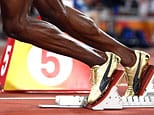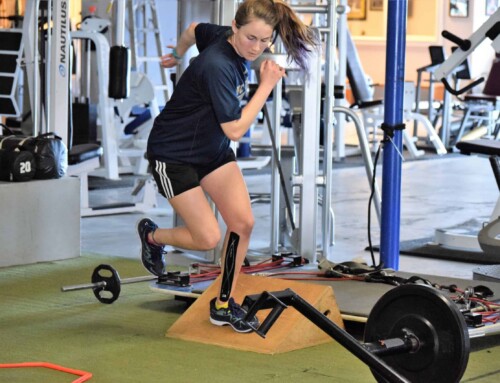Well its about that time. Time to get started on your off season training. Most who know me understand I’m not a big tester. But for those of you who want hard numbers on how to evaluate where you are, you can perform some fairly good tests to see at what point you are in your development.
Listed below are some tests you can perform to give you a better picture of your development. Periodic testing can be informative but it is not the last word. Some people are great testers but can’t perform on the track. I’ve listed some general parameters found in developmental and elite level athletes. Use these as a guide to shoot for but don’t use them as a pass/fail mechanism. Compare your improvement with yourself.
Acceleration
- Assume three point or track stance, when ready sprint to desired mark, the timer starts on the first movement (generally the hand). Record 2-3 trials.
- 10,20, or 30yd Fly: This entails marking the appropriate distance and have the athlete approach at full speed and run through the distance 10,20 or 30m at full speed. Time the distance for a maximum speed score. Perform three trials and record the best score. Parameters for 20m fly: Age 12 (2.20-2.30), Age 15 (2.10-2.20) Age 18 2.00-under).
Max Speed
- 10,20, or 30yd Fly: This entails marking the appropriate distance and have the athlete approach at full speed and run through the distance 10,20 or 30m at full speed. Time the distance for a maximum speed score. Perform three trials and record the best score. Parameters for 20m fly: Age 12 (2.20-2.30), Age 15 (2.10-2.20) Age 18 2.00-under).
Lower Body Strength
- Leg Press or Squat: Perform 1-2 warm-up sets, then perform your one rep maximum. Divide your body weight into the total pounds lifted to find your leg strength to body weight ratio.
Upper Body Strength
- Bench Press: Perform 1-2 warm-up sets, and then perform your one rep maximum. Divide your body weight into the total pounds lifted to find your leg strength to body weight ratio.
Explosive Power Lower Body
- Speed Squat: squat to parallel position 80% of body weight 5 reps. Males under 4.30, Females under 5.0.
- Standing Long Jump: Parameters: Age 12 (2.20cm), Age 15-16 (2.70cm), Age 18+ (2.90-3.0)
- Vertical Jump: Parameters: Age 12 (22-23in), Age 15-16 (27-28in) Age 18+ (29-31)
Explosive Power Upper body
- Seated Medicine Ball Chest Throw: Seated, feet flat on the floor, sitting straight up (ideally chest or hips strapped securely) Hold ball close to the chest with both hands and elbows flexed. Extend arms and elbows to throw ball at maximum effort for distance. Score the best of three trials.
- Med. Ball Between legs, forward throw: Standing with feet shoulder width apart, swing ball down between the legs bending knees, swing upward and release the ball throwing forward for maximum distance. Record the best of three trials. Parameters: Using an 8lb medicine ball: Age 12 (10yds), Age 15 (13yds), Age 18 (18yds)
- Med. Ball Overhead, forward throw: Standing with feet shoulder width apart, swing ball back and overhead, then forward, release the ball throwing forward for maximum distance. Record the best of three trials.
Endurance
- 4x100yd Repeats: Sprint 100yds, rest 30 seconds, repeat, until four runs are completed. Record 4 scores for average.
Quickness
- Quick hands test: Place 20 markers, sticks etc, and 18 inches apart for a total distance of 10yards. Pumping arms and using very little knee lift and the athlete runs through. Timing starts when the foot lands between the first and second stick and after the last stick. Record the best of three trials.
- Quick Feet test: Stand in front of a wall arms extended with palms flat against it. Time for 20 seconds the number of times you can strike the wall with the palm of your hand. Record the best of three trials.
Core Strength
- Vertical leg Hang: While hanging from a pull up bar bring the legs up and straight out keeping the body in an “L” position. Parameters: Age 15 (15 seconds), Age 18 (22 sec), Age 19+ (30 sec).
Calculating Stride Frequency (Rate)
- Perform a 30 m fly: Beginners use 15m acceleration approach (Elite 20m) up to full speed. The fly zone will be 30m in length. The timer starts the watch when the right foot lands within the zone and stops the watch when the right foot strikes 5 times. To calculate:
“Time” divided by “strides taken” = Strides/Sec (Rate)
Example: 2.2 divided by 10 strides= 4.5 strides per sec (Rate)
Developmental athletes: 3.8-4.4 Elite Athletes: 4.5-5.0
Calculating Speed Endurance
- Perform a 60m fly: Beginners use 15m acceleration approach (Elite 20m) up to full speed. The fly zone will be 60m in length but will be broken up into two 30m segments. Time each segment. You want to have a 3% differential between the first 30m and second 30m segments for elite athletes and 5-6% for developmental athletes.
Example: First 30m 3.0 x .03 (3%) = 3.09 differential
Calculate Acceleration Capabilities
- Take a standing 30m time and subtract your flying 30m time. Developmental athletes score: 1.4 differential and elite score around 1.0.
Example: Standing 30m – Fly 30m = Acceleration Differential


